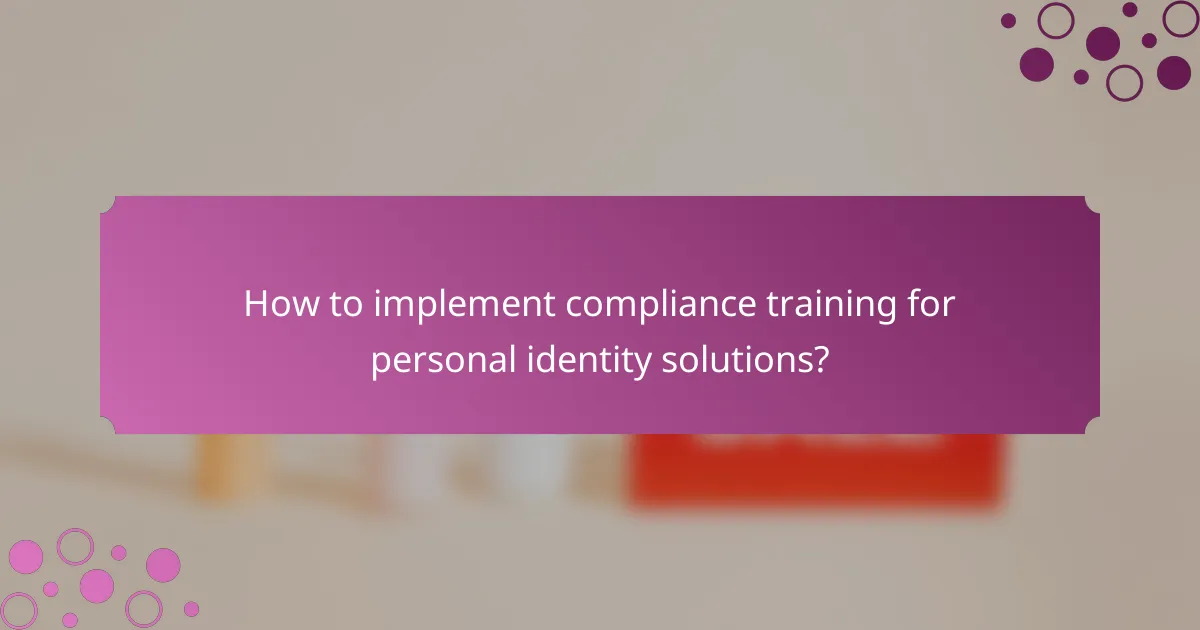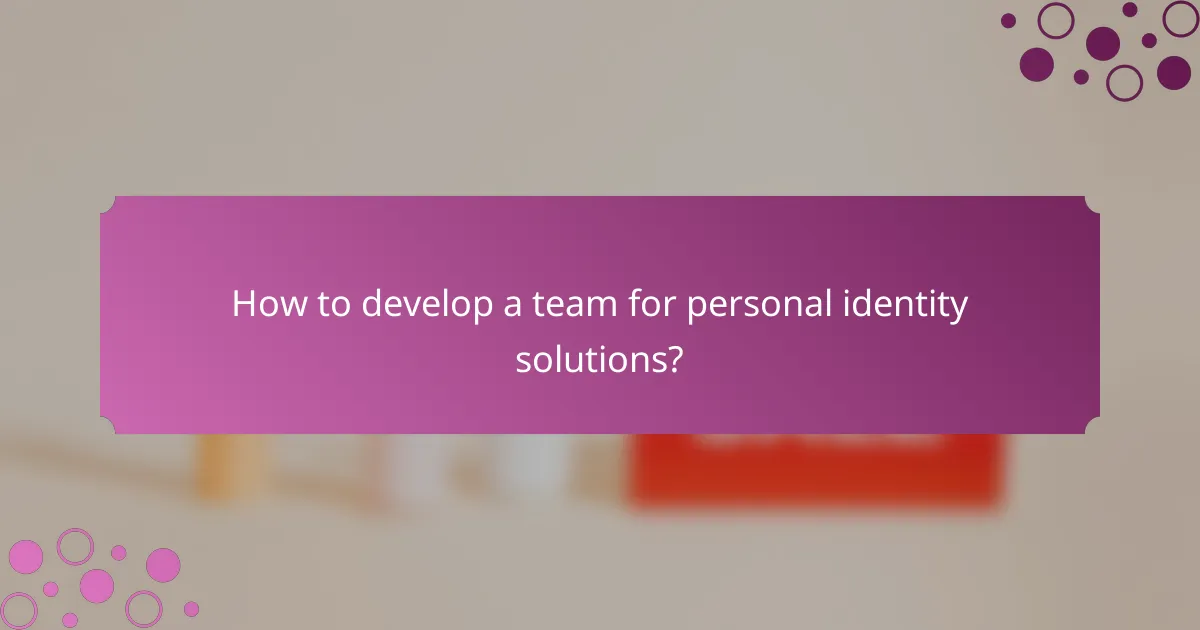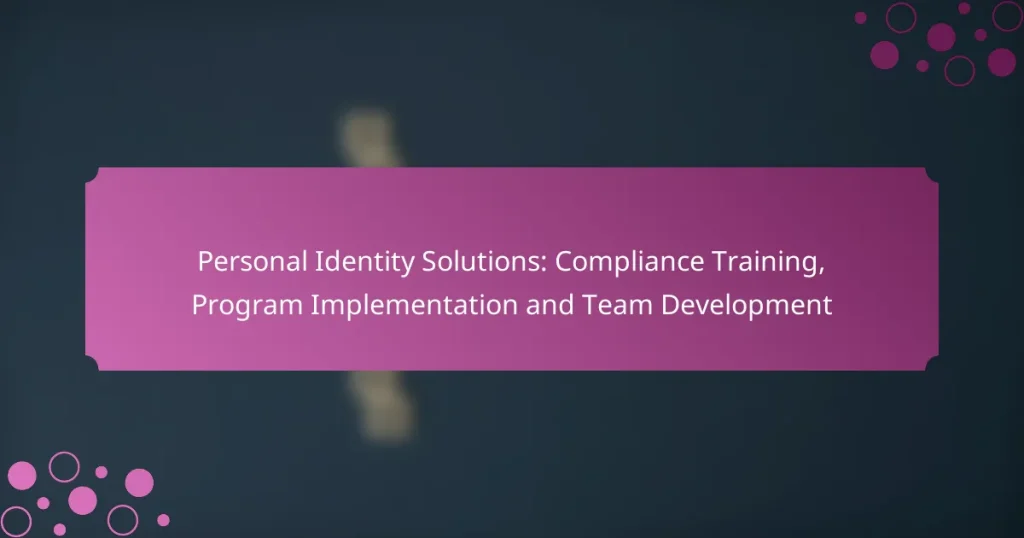Personal identity solutions in the UK are essential for enhancing security, ensuring compliance, and improving user experience through effective identity verification and data protection. Implementing compliance training and program development requires a structured approach that includes understanding regulatory requirements, engaging stakeholders, and monitoring progress to adapt to challenges. By focusing on these elements, organizations can foster a culture of compliance and security within their teams.

What are the best personal identity solutions in the UK?
The best personal identity solutions in the UK focus on enhancing security, ensuring compliance, and improving user experience. These solutions include a variety of tools and programs designed to verify identities, protect data, and manage access effectively.
Identity verification software
Identity verification software is essential for confirming the authenticity of individuals’ identities. These tools typically use biometric data, government-issued IDs, and other verification methods to ensure that users are who they claim to be.
When selecting identity verification software, consider factors such as integration capabilities, user experience, and compliance with UK regulations like the General Data Protection Regulation (GDPR). Popular options include Onfido and Veriff, which offer robust verification processes.
Data protection training programs
Data protection training programs educate employees on best practices for handling personal information securely. These programs often cover topics like GDPR compliance, data breach response, and secure data handling techniques.
Implementing regular training sessions can significantly reduce the risk of data breaches. Look for programs that offer interactive modules and real-world scenarios to enhance engagement and retention of information.
Compliance management tools
Compliance management tools help organizations adhere to legal standards and regulations regarding personal identity and data protection. These tools streamline the process of tracking compliance requirements and managing audits.
Consider platforms like LogicGate or ComplyAdvantage, which provide customizable compliance workflows and reporting features. Regularly updating these tools is crucial to stay aligned with evolving regulations in the UK.
Identity access management systems
Identity access management (IAM) systems control user access to sensitive information and resources within an organization. These systems ensure that only authorized personnel can access specific data, reducing the risk of unauthorized access.
When choosing an IAM system, prioritize features such as single sign-on (SSO), multi-factor authentication (MFA), and user provisioning. Solutions like Okta and Microsoft Azure Active Directory are popular choices that offer comprehensive IAM functionalities.
Fraud prevention solutions
Fraud prevention solutions are designed to detect and prevent fraudulent activities related to identity theft and financial fraud. These tools often use machine learning algorithms to analyze patterns and flag suspicious behavior in real-time.
Look for solutions that offer features like transaction monitoring, risk scoring, and user behavior analytics. Companies like Riskified and Sift provide effective fraud prevention services tailored for various industries in the UK.

How to implement compliance training for personal identity solutions?
Implementing compliance training for personal identity solutions involves understanding regulatory requirements, developing effective training materials, scheduling sessions, and assessing employee understanding. This structured approach ensures that employees are well-informed about compliance standards and best practices.
Identify regulatory requirements
Start by researching the specific regulations that apply to personal identity solutions in your region. Common regulations include the General Data Protection Regulation (GDPR) in Europe and the Health Insurance Portability and Accountability Act (HIPAA) in the United States. Understanding these requirements is crucial for tailoring your training program.
Consult with legal experts or compliance officers to ensure you capture all relevant laws. This step helps avoid potential penalties and ensures that your training aligns with industry standards.
Develop training materials
Create training materials that clearly explain the identified regulatory requirements and their implications for personal identity solutions. Use a mix of formats, such as presentations, handouts, and interactive modules, to cater to different learning styles.
Include real-world scenarios and case studies to illustrate compliance challenges and solutions. This practical approach helps employees relate the training content to their daily responsibilities.
Schedule training sessions
Plan training sessions at times that maximize attendance, considering employees’ work schedules and time zones if applicable. Offering multiple sessions can accommodate different shifts and ensure everyone has the opportunity to participate.
Utilize both in-person and online formats to enhance accessibility. Online platforms can provide flexibility, allowing employees to engage with the material at their convenience.
Assess employee understanding
After training, evaluate employee understanding through quizzes, surveys, or practical assessments. This feedback helps identify areas where further training may be necessary and reinforces key concepts.
Consider implementing regular refresher courses to keep compliance knowledge current, especially as regulations evolve. Continuous assessment and training help maintain a culture of compliance within the organization.

What are the key components of a successful program implementation?
A successful program implementation hinges on effective stakeholder engagement, clear objectives, proper resource allocation, and robust monitoring and evaluation. These components ensure that the program meets its goals and adapts to any challenges that arise during execution.
Stakeholder engagement
Engaging stakeholders is crucial for program success, as their support can drive participation and resource commitment. Identify key stakeholders early, including team members, management, and external partners, and involve them in the planning process to foster ownership.
Regular communication with stakeholders helps maintain alignment and address concerns promptly. Consider using surveys or feedback sessions to gauge their perspectives and adapt the program accordingly.
Clear objectives and goals
Establishing clear objectives and goals provides a roadmap for the program. These should be specific, measurable, achievable, relevant, and time-bound (SMART) to facilitate tracking progress and outcomes.
For example, instead of a vague goal like “improve compliance,” specify “achieve a 90% compliance rate within six months.” This clarity helps teams focus their efforts and assess success effectively.
Resource allocation
Effective resource allocation ensures that the necessary tools, personnel, and budget are available to support the program. Assess the resources required based on the defined objectives and allocate them efficiently to avoid bottlenecks.
Consider creating a budget plan that outlines expected costs and identifies potential funding sources. Regularly review resource usage to make adjustments as needed and prevent overspending.
Monitoring and evaluation
Monitoring and evaluation are essential for assessing program effectiveness and making data-driven adjustments. Implement a system for tracking progress against the established goals, using metrics that reflect both qualitative and quantitative outcomes.
Schedule regular evaluation sessions to review findings and gather insights from stakeholders. This iterative process allows for timely modifications and enhances overall program performance.

How to develop a team for personal identity solutions?
To develop a team for personal identity solutions, focus on clearly defining roles, providing continuous training, fostering collaboration, and utilizing performance metrics. These elements ensure that team members are equipped to handle compliance training and program implementation effectively.
Define roles and responsibilities
Clearly defining roles and responsibilities is crucial for a team focused on personal identity solutions. Each member should understand their specific duties, whether in compliance training, program implementation, or team development.
Consider creating a responsibility matrix to outline who is accountable for what tasks. This can help avoid overlaps and ensure that all necessary areas are covered.
Provide ongoing training
Ongoing training is essential to keep the team updated on the latest regulations and best practices in personal identity solutions. Regular workshops and training sessions can help reinforce knowledge and skills.
Implement a training schedule that includes both initial onboarding and periodic refreshers. This approach keeps the team informed about changes in compliance requirements and emerging technologies.
Encourage collaboration
Encouraging collaboration among team members enhances problem-solving and innovation in personal identity solutions. Create an environment where open communication is valued, allowing team members to share insights and strategies.
Utilize collaborative tools and platforms that facilitate teamwork, such as project management software or shared document systems. This can streamline processes and improve overall efficiency.
Utilize performance metrics
Utilizing performance metrics helps assess the effectiveness of the team in delivering personal identity solutions. Establish key performance indicators (KPIs) that align with your goals, such as compliance rates or project completion times.
Regularly review these metrics to identify areas for improvement. This data-driven approach can guide training efforts and resource allocation, ensuring that the team remains focused and effective.

What are the challenges in personal identity compliance training?
Personal identity compliance training faces several challenges, including keeping pace with evolving regulations, ensuring employee engagement, and integrating training into existing workflows. Organizations must navigate these complexities to maintain compliance and protect sensitive information.
Keeping up with regulatory changes
Regulatory changes in personal identity compliance can occur frequently, making it essential for organizations to stay informed. This requires a proactive approach to monitor updates from relevant authorities, such as the GDPR in Europe or HIPAA in the United States.
To effectively manage these changes, companies should establish a dedicated compliance team responsible for tracking regulations and implementing necessary training updates. Regular audits and assessments can help identify gaps in knowledge and ensure that training materials reflect the latest requirements.
Additionally, leveraging technology, such as compliance management software, can streamline the process of updating training programs. This allows organizations to quickly disseminate information to employees and maintain compliance without significant disruptions to operations.


